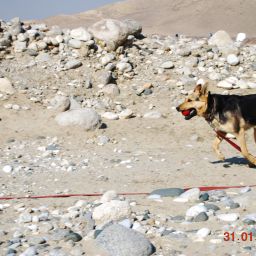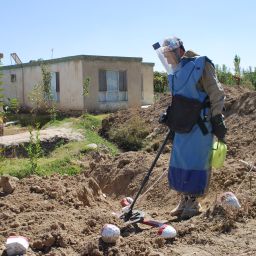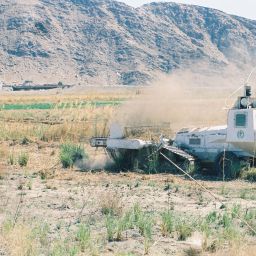
The term “mine risk education” (MRE) refers to “activities which
seek to reduce the risk of injury from mines and explosive remnants of war (ERWs) by raising awareness and promoting behavioral change, including public information dissemination, education and training.” Mine Risk Education (MRE) is one of the vital components of the Mine Action toolbox, used by the United Nations Mine Action Center for Afghanistan (UNMACA) to diminish Mine/UXO accidents and casualties.
Since year 2005 ATC started community-based mine risk education
(MRE). MRE trainers are selected from the impacted communities; these trainers will remain as focal points for future references. Simultaneously, needy villagers are getting job opportunities as well as people from the community proved to be more successful than people from other areas.
Now, ATC has 9 community-based MRE teams working in the central and western regions of the country.
By having the SMART characteristics i.e. Sustainability, Measure ability, Achievability, Reliability and Time-bound, ATC MRE is one of the victorious programs around the country.
Following are the main social-economical objectives of the program:
- The safe return of refugees and internally displaced persons to their homes and villages
- To encourage people to return back to their villages, normalize their lives and initiate their productive activities to develop their country
- To minimize mine accidents in mine and UXO-affected areas as well as to reduce the mine threat by providing MRE
- To provide low cost Community Based Mine Risk Education (MRE) program in order to alleviate human suffering,
- To mobilize and organize communities in order to build their capacities towards a socially amenable environment for rehabilitation as well as the development of self-help initiatives. This will encompass a special focus on livelihood support;
- food-security and poverty alleviation,

- To introduce and promote alternative sources of energy with the aim of avoiding further degradation of environment,
- To assist local people by providing job opportunities through the community based mine risk education program
- To reduce injuries and casualties related to mines and UXO in Afghanistan by raising awareness,
- To promote safe behavior in affected communities.
Since late 1998, and in order to educate the Afghan people living in mine affected areas, after demining operations were completed, ATC started using demining team members to voluntarily teach local people about the risks and hazards regarding mines and UXO. Deminers conducted these education sessions in their free time. The logic behind this is to help reduce civilian casualties and to assist the UN Mine Awareness Program. ATC Program is partially effective as it involves people who have first-hand knowledge of the area they cleared surrounding their villages.
A True Story
The story was told to one of ATC Site Officer while visiting an impacted community at Khalawak village, Khushk district, Hirat province.
The Site Officer says: In October 2008, I went to Khalawak village to perform pre-mine awareness activities before assigning VTF funded MRE team no. 9 in this village. As I was introducing myself to the villagers and explaining what I had come to do, one of the men began to cry. He told me that only two weeks before his two sons had been killed in a mine accident. I asked him to tell me what had happened. As he spoke tears fell from his eyes:
“Now it is spring, he said, and the deserts are green. We have a lot of sheep and the weather was good, so I asked my two sons, aged six and nine, to go a little way to graze the animals. Shortly afterwards, as I was at home, I heard a huge explosion. The other villagers and I rushed towards the sound. When we arrived the whole area was covered in dust and smoke.
My two sons had been thrown far in the explosion. Many parts of their bodies were completely missing. We took what we could find of them back to our home. When we entered the village my wife, their mother, was there to meet us. She was weeping and screaming at the sight of the bodies of her children. I wish that God would take this disaster from our country. I wish that you (the mine awareness person) had come a month ago. Why should it happen so?”
Apart from expressing the need for mine risk education, this story also provides the necessary background for the establishment and maintaining of the community-based approach. This kind of stories is part of the daily life of most communities living in impacted areas of Afghanistan. Therefore, they provide a very solid basis to refer to when one tries to establish a mine awareness capacity at a village level. There are different ways to respond to the plight of this mother who says “I wish that you had come a month ago”.
- One way is to provide the community with the visit of a mine awareness trainer who is going to deliver a presentation to the community.
- Another way is to work with the community in order to enable it to tackle the problem on a daily basis with a limited external input.
- The third way is to work with the existing schools (mosques and madrassas).
- The fourth way is to use the existing media, i.e. the BBC Pushto and Dari services.
Challenges Faced By MRE Trainers
Both Central and Western regions are known as coldest areas of the country. In general winter is the most difficult season, because of no proper heating facilities available at the remote villages or even some towns. Since, the MRE trainers visited isolated areas, faced different anxieties, i.e. blockage of access roads because of heavy snowfalls, no suitable place for conducting MRE sessions, lack of livable lodges, deficiency of sanitary food and other ecological obstacles. The VTF funded MRE trainers having a great humanitarian and compassionate spirit continued their job with honesty and willingness





